How to Get Rid of Japanese Beetles
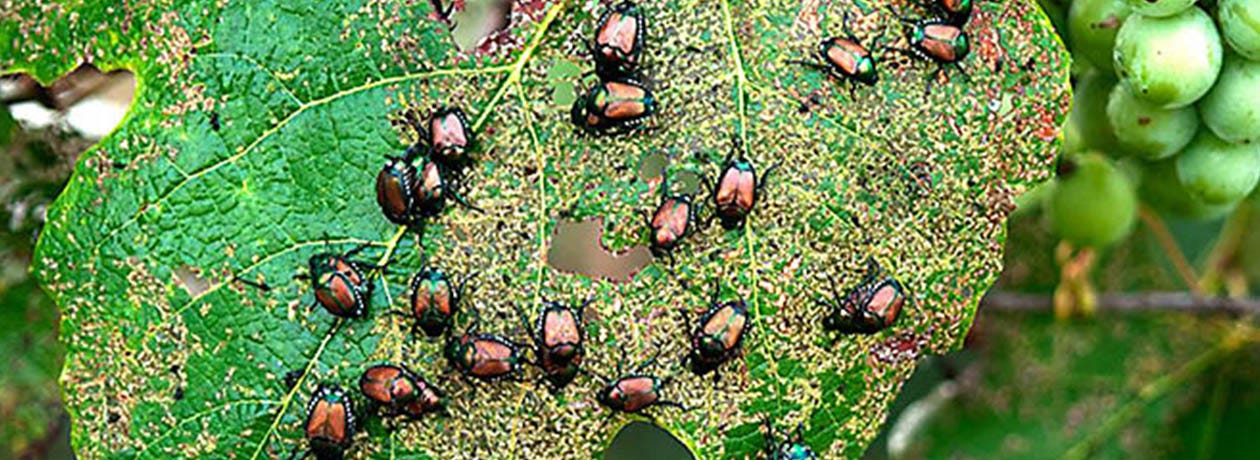
Many backyard events can be spoiled by the presence of Japanese Beetles. The season when the adult beetles are most active in their feeding is relatively short, usually for several weeks during the middle of summer. The damage they can cause during that time, however, can be extensive. Using a product such as Safer® Brand Japanese Beetle Trap will keep your backyard festivities free of these bothersome pests.
Japanese beetle traps should be placed outside at the first spotting of a Japanese beetle. Read more about these annoying insects and how to control them.
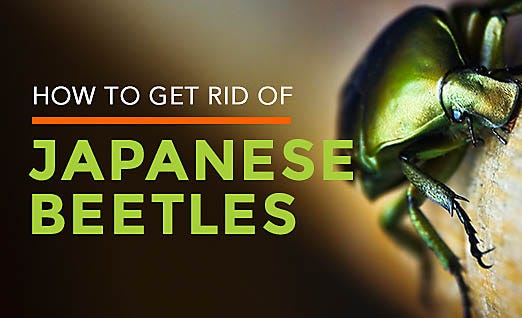
So... What's a Japanese Beetle?
Japanese Beetles are voracious leaf-feeders and cause damage to a large variety of plants in a homeowner's lawn, landscape and garden.
Adult Japanese Beetles measure about 1/2" in length and have shiny bluish green bodies that appear metallic in the sunlight. The copper or bronze colored wings add to this metallic appearance.
The larvae, often referred to as grubs or white grubs, measure about 3/4" in length and go through several instar or mini-stages. Eliminating Japanese Beetles begins with controlling the larvae. Using a product such as Safer® Brand Grub Killer will eliminate the larvae that cause Japanese Beetles.
Reproduction Patterns of Japanese Beetles
The white grubs or Japanese beetle grub larvae overwinter down in the ground, and then in the spring, move upward toward plant roots to feed. After developing into a pupal stage at the beginning of summer, the pupae emerges as an adult and begins to feed on the plants around it.
The adults mate and the female deposits eggs in the soil during the middle to latter part of summer. After the eggs hatch, the larvae will dig into the soil to spend the winter. This life cycle may take a year or two. Be sure you do not have this life cycle happening in your yard by using a product such as Safer® Brand Grub Killer to eliminate the Japanese Beetles at the larval stage.
Japanese Beetle's Habitat
First found in the United States in 1916, this insect has spread to almost all areas east of the Mississippi River. Smaller pockets of infestation have been found in areas west of the Mississippi, but they have not infiltrated to the entire western part of the country at this point.
These destructive insects can be found in vegetable gardens, flower gardens, fruit trees, and shrubs. They also infest agricultural fields, golf course greens, and woodlands and parks.
Interestingly, the Japanese Beetle is not a problem in its native country like it is here, because in Japan this pest's natural predators keep it under control. If you do have Japanese Beetles that have grown out of the larval stage, using a product such as Safer® Brand Japanese Beetle Trap, will help eliminate your problem and give you back control of your yard.
Symptoms of Japanese Beetle Damage
Japanese Beetles may be attractive in their physical appearance, but their damage certainly is not. One beetle by itself doesn’t necessarily cause that much destruction to the plant, but when they conglomerate and feed in groups, then the real damage happens. Once they begin feeding, they send out a pheromone alerting other beetles in the area to where the good locations for food are. They can’t fly very long distances, but they can travel far enough to get to adequate food sources.
Once you start to see evidence of Japanese Beetles on roses or other plants you may have in your garden, it’s important to be vigilant in getting rid of these pests to prevent further damage.
Leaves with multiple holes, skeletonized plants, and brown patches of grass are all symptoms that may indicate the presence of Japanese beetles, both adults and grubs. It is often easy to see the adult beetles as they land and feed on the leaves of plants and trees.
Results of a Japanese Beetle Infestation
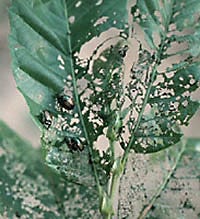
The beetles are especially attracted to plants in direct sunlight and tend to begin feeding near the tops of the plant, working their way down. Their powerful jaws are lethal to plant tissue in between the veins. Once the tissue is destroyed, only the veins remain. This gives the leaves a skeleton-like look.
While adult beetles cause the most visible damage to plants’ leaves, beetle larva can also be particularly detrimental to plants’ roots.
Here are some other results of Japanese Beetle Damage:

Leaves are decimated and can no longer support the plant. When the leaves have many holes and gaps in their tissue, they are no longer able to spread nutrients effectively nor photosynthesize, and the whole plant will eventually die.

Plants look like skeletons of themselves. The beetles feed on the plant tissue and leave only the veins, creating a tell-tale skeleton appearance.

Grass may turn brown where the grubs have eaten the lawn's roots. Since the larva spends the winter under the soil, the grass’ roots provide the perfect food source. Once the roots are decimated, the grass dies in those spots.

Blossoms may look stunted or jagged. The beetles also like to feed on blossoms. Since there are no veins in the blossom, you might see more of a jagged pattern around the edges of the petals.
When you’re determining how to kill Japanese Beetles using a product such as Safer® Brand Grub Killer will eliminate the Japanese Beetles at their larval stage, and Safer® Brand Japanese Beetle Trap will eliminate adult beetles and allow your plants and grass to grow healthy, all year long.
These striking but destructive beetles can destroy plants, trees, and grassy areas, leading to plant loss, crop loss, and financial loss.
Types of Plants Favored By the Japanese Beetle
While Japanese Beetles are open to feeding on a wide variety of plants, they do have their favorites, and the smell of the plant often plays a large part in attracting these insects. Some plants the beetles find especially appealing include:
- Japanese and Norway Maples
- Gray Birch
- Hollyhock
- Roses
- A variety of fruit trees including cherry, peach and plum
- Sassafras
- Sunflowers
- Dahlia
- Grape
- Gladiolus
In addition to a variety of plants, there are many types of weeds the beetles like to feed on as well. Eliminating those from your garden as much as possible may also help to make your yard less favorable to these pests. Weeds to get rid of include:
- Poison ivy
- Smartweed
- Indian mallow
- Wild summer grape and wild fox grape
Controls for Japanese Beetles
Safer® Brand offers suggestions and strategies for Japanese beetle control that are perfect for ridding your garden of these voracious eaters. Learn how to take advantage of the beetle’s natural predators, as well as create an environment for Japanese beetle control.
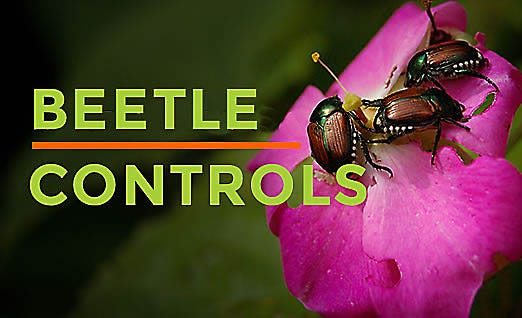
What Are Some Ways of Killing Japanese Beetles?
Bag traps for Japanese Beetles are a popular way to control this pest in the yard & garden. The combination of Insecticidal Soap and Botanical Pyrethrins will also kill the Japanese Beetles on contact if they are spotted on your plants.
How Do These Methods Work?
Bag Traps — Hang the bag from a trap stand or an outdoor fixture. Make sure to hang the bag away from outdoor living spaces and away from your home as it has a bait that will lure the Japanese Beetles in, trapping and killing them. Bag traps are typically baited with a food attractant, sex attractant or both.
Keep a close eye on your Japanese Beetle traps to ensure they aren’t getting too full. Since the attractant is so strong, it may lure in beetles from other close-by locations besides your garden. Once the traps start filling up with dead or dying insects, it’s a good idea to replace them to help keep control.
As an added control measure, use a grub killer in conjunction with this trap. This will kill any grubs in the soil in case a female Japanese Beetle lays her eggs prior to entering the trap and can help prevent a possible infestation later. See also All About White Grubs to learn more about the damage caused by the larval stage of this pest.
You might also be able to determine if your lawn is infested with grubs by lifting a small area, about one square foot, and seeing how many grubs you can spot. If there are a dozen or more, then you could have a problem. A grub control method may help ensure those grubs don’t all turn into adults.
Insecticidal Soap (Potassium Salts of Fatty Acids) & Pyrethrin — Combined, these ingredients are the equivalent of a 1-2-knock-down punch. Japanese Beetles, like other hard-bodied insects, are tough bugs to kill. The soap will penetrate their shell enough to weaken and dehydrate the insect and allow the pyrethrin to absorb into the insect and do its job. Pyrethrin is a nerve agent that will paralyze and kill the insect on contact.
Keep in mind this soap is not like dish detergent; it's a base from a blend of plant sources and pyrethrin oils which come from the chrysanthemum flower.
Safer® Brand offers a variety of Japanese Beetle control products to help control and eliminate this garden pest and revive your plants. Please check out our Japanese Beetle control products for more details about how they work and how, when, where they should be applied.
When Is the Best Time to Use These Methods?
Bag traps should be placed outside at the first spotting of a Japanese beetle. For maximum Japanese beetle control, have your neighbors place Japanese traps at the same time.
Apply grub killer as directed on the product label to prevent grub damage, making sure to do one final application in the fall before the frost to kill the last of the grubs before they dig in deep to overwinter and molt into next year's Japanese Beetles.
Spray Insect Soap & Pyrethrin as a contact killer. Use in accordance with directions on the product label.
If you are concerned about a plant or unsure of how it will react to these solutions, test an inconspicuous area and wait 24 hours before applying full coverage. As a general rule, much like watering, do not use any liquid insecticides in the peak of the day or when temperatures exceed 90°F.
Natural Predators to Japanese Beetles
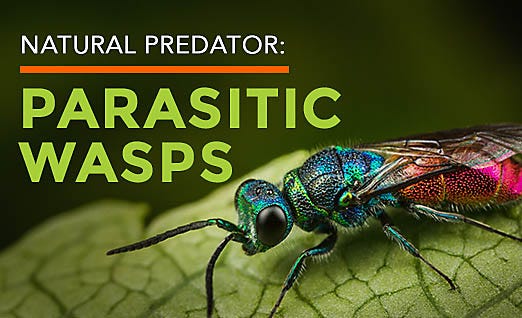
Another method of Japanese Beetle control is letting nature take its course and allowing natural predators to feed on the beetles.
What Are Some Natural Predators?
Parasitic wasps are a natural method of controlling the Japanese Beetle.
How Do They Help?
The parasitic wasp lays its eggs on the Japanese Beetle, and its larvae that hatch will feed inside, usually resulting in the death of the host insect.
Planting nectar- or pollen-producing plants may attract parasitic wasps. These wasps don’t possess mouth parts necessary for reaching into deeper, tubular flowers. Instead, they tend to favor plants with shallow flowers where nectar or pollen is easy to get. Some plants they may find attractive are:
- English lavender
- Mint
- Dill
- Fennel
- Sweet alyssum
You can also ask your local garden center the best plants for your area. The difficulty with relying solely on natural predators is that if their food source is not adequate, they won’t stay around. If you’re worried about being able to attract them, the insects may also be purchased by commercial growers of the insect.
For the ultimate defense, you can pair natural predators with the use of Japanese Beetle traps and Safer® Brand’s other Japanese Beetle control products to help keep these pests from getting out of hand.
When Are They Most Effective?
The purchase of parasitic wasps can be done at any time during the season the beetles are present.
Nectar or pollen producing plants should be planted as an aid in attracting parasitic wasps. Most local greenhouses and garden centers can help you determine the right planting time for your area.
Other Natural Predators
Robber flies and praying mantis are other insects that may also feed on the beetles. While most natural predators of the Japanese Beetle don’t live in the United States, which is the reason these pests often get out of hand, there are a number of bird species that may feed on the adults as well as on the grubs underground:
- Starlings
- Robins
- Song sparrows
- Red-winged blackbirds
- Crows
- Meadowlarks
Moles and shrews also may eat the grubs in your yard, but they can cause further damage to your garden as they dig holes and tunnels throughout the space.
What Are Some Other Options for Getting Rid of Japanese Beetles?
The beetles are easy to spot, and they are slow flyers and slow movers. Knocking beetles off bushes, trees, and plantings is a simple method of controlling them.
Planting certain plants, shrubs, bushes and trees that do not attract the beetles will help to control the beetles in your yard. Row covers may help protect your vegetable plantings.
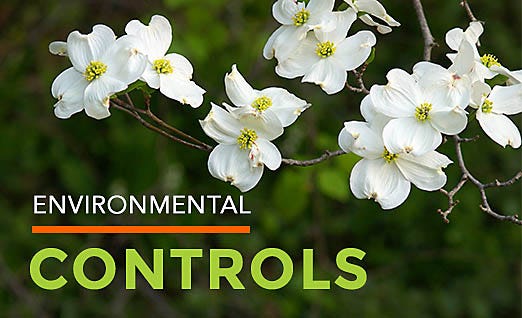
Some plants the beetles don’t commonly feed on or avoid all together include:
- Boxelder
- Boxwood
- Dogwood
- Magnolia
- Holly
- White Poplar
- Geraniums
How Do These Methods for Killing Japanese Beetles Work?
The same process generally applies, no matter the type of plant you are ridding of the beetle. If you are simply picking the beetles off the plant, you’ll want to make sure you don’t just knock them onto the ground. Take a cup or bucket and fill it with soapy water. Knock the beetles into the cup. The soap will help prevent them from escaping their wet tomb. If there are many beetles, you can shake them into a cloth first before knocking them into the bucket of soapy water.
When planting shrubs, trees, bushes or flowers that do not attract Japanese beetles, check with your local garden center to see which kinds "fit the bill." In addition to the list above, a few other common plants include carnations, daisies, snapdragons, violets, pansies, begonias, forsythias, lilacs, arborvitae and fir trees.
If Japanese Beetles are attacking plants in your garden or fields, you can opt to use a floating row cover to protect the plantings from the beetles. These can be purchased at home and garden centers.
When Is the Best Time to Employ These Methods?
When handpicking with a cup or bucket of soapy water, it is best to do this in the morning or evening when the air is cooler and the beetle is less active, making it easier to knock off the plant and into the water.
Planting shrubs, trees and flowers that are not attractive to the Japanese beetles should be done according to your climate zone. If unsure, ask at your local garden center. It is best to plant certain trees and shrubs in the fall. Flower bulbs should also be planted in the fall, while annuals are usually planted in the spring, depending on the type of flower and the climate zone and temperature of your area.
Follow directions for using a floating row cover so it can provide the most effective protection from beetles.
